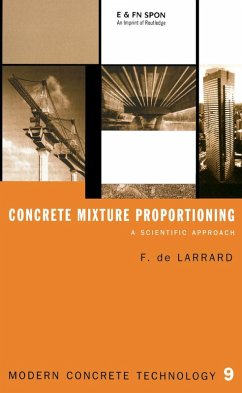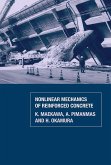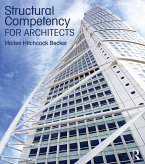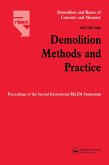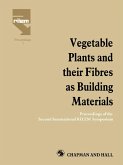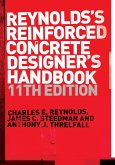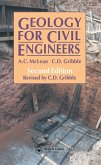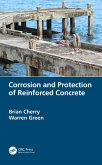65,95 €
65,95 €
inkl. MwSt.
Sofort per Download lieferbar

33 °P sammeln
65,95 €
Als Download kaufen

65,95 €
inkl. MwSt.
Sofort per Download lieferbar

33 °P sammeln
Jetzt verschenken
Alle Infos zum eBook verschenken
65,95 €
inkl. MwSt.
Sofort per Download lieferbar
Alle Infos zum eBook verschenken

33 °P sammeln
- Format: ePub
- Merkliste
- Auf die Merkliste
- Bewerten Bewerten
- Teilen
- Produkt teilen
- Produkterinnerung
- Produkterinnerung

Bitte loggen Sie sich zunächst in Ihr Kundenkonto ein oder registrieren Sie sich bei
bücher.de, um das eBook-Abo tolino select nutzen zu können.
Hier können Sie sich einloggen
Hier können Sie sich einloggen
Sie sind bereits eingeloggt. Klicken Sie auf 2. tolino select Abo, um fortzufahren.

Bitte loggen Sie sich zunächst in Ihr Kundenkonto ein oder registrieren Sie sich bei bücher.de, um das eBook-Abo tolino select nutzen zu können.
Concrete Mixture Proportioning provides a comprehensive theory for the rational design of concrete mixtures. It allows the user to achieve an internationally applicable mastery of concrete material through the use of computer software.
- Geräte: eReader
- ohne Kopierschutz
- eBook Hilfe
- Größe: 13.07MB
Andere Kunden interessierten sich auch für
![Non-Linear Mechanics of Reinforced Concrete (eBook, ePUB) Non-Linear Mechanics of Reinforced Concrete (eBook, ePUB)]() K. MaekawaNon-Linear Mechanics of Reinforced Concrete (eBook, ePUB)65,95 €
K. MaekawaNon-Linear Mechanics of Reinforced Concrete (eBook, ePUB)65,95 €![Structural Competency for Architects (eBook, ePUB) Structural Competency for Architects (eBook, ePUB)]() Hollee Hitchcock BeckerStructural Competency for Architects (eBook, ePUB)91,95 €
Hollee Hitchcock BeckerStructural Competency for Architects (eBook, ePUB)91,95 €![Demolition Methods and Practice V1 (eBook, ePUB) Demolition Methods and Practice V1 (eBook, ePUB)]() Y. KasaiDemolition Methods and Practice V1 (eBook, ePUB)52,95 €
Y. KasaiDemolition Methods and Practice V1 (eBook, ePUB)52,95 €![Vegetable Plants and their Fibres as Building Materials (eBook, ePUB) Vegetable Plants and their Fibres as Building Materials (eBook, ePUB)]() Vegetable Plants and their Fibres as Building Materials (eBook, ePUB)34,95 €
Vegetable Plants and their Fibres as Building Materials (eBook, ePUB)34,95 €![Reinforced Concrete Designer's Handbook (eBook, ePUB) Reinforced Concrete Designer's Handbook (eBook, ePUB)]() Charles E. ReynoldsReinforced Concrete Designer's Handbook (eBook, ePUB)81,95 €
Charles E. ReynoldsReinforced Concrete Designer's Handbook (eBook, ePUB)81,95 €![Geology for Civil Engineers (eBook, ePUB) Geology for Civil Engineers (eBook, ePUB)]() C. GribbleGeology for Civil Engineers (eBook, ePUB)89,95 €
C. GribbleGeology for Civil Engineers (eBook, ePUB)89,95 €![Corrosion and Protection of Reinforced Concrete (eBook, ePUB) Corrosion and Protection of Reinforced Concrete (eBook, ePUB)]() Brian CherryCorrosion and Protection of Reinforced Concrete (eBook, ePUB)65,95 €
Brian CherryCorrosion and Protection of Reinforced Concrete (eBook, ePUB)65,95 €-
-
-
Concrete Mixture Proportioning provides a comprehensive theory for the rational design of concrete mixtures. It allows the user to achieve an internationally applicable mastery of concrete material through the use of computer software.
Dieser Download kann aus rechtlichen Gründen nur mit Rechnungsadresse in A, B, BG, CY, CZ, D, DK, EW, E, FIN, F, GR, HR, H, IRL, I, LT, L, LR, M, NL, PL, P, R, S, SLO, SK ausgeliefert werden.
Produktdetails
- Produktdetails
- Verlag: Taylor & Francis eBooks
- Erscheinungstermin: 4. März 1999
- Englisch
- ISBN-13: 9781040075357
- Artikelnr.: 73212722
- Verlag: Taylor & Francis eBooks
- Erscheinungstermin: 4. März 1999
- Englisch
- ISBN-13: 9781040075357
- Artikelnr.: 73212722
- Herstellerkennzeichnung Die Herstellerinformationen sind derzeit nicht verfügbar.
Francois De Larrard
1. Packing Density and Homogeneity of Granular Mixes 1.1. Virtual Packing
Density of a granular mix 1.2. Actual Packing Density - The Compressible
Packing Model (CPM) 1.3. Effect of Boundary Conditions on the Mean Packing
Density 1.4. Granular Mixes of Maximum Packing Density 1.5. Segregation of
Granular Mixes 1.6. Summary 2. Relationships Between Mix Composition and
Properties of Concrete 2.1. Fresh Concrete Properties 2.2. Adiabatic
Temperature Rise 2.3. Compressive Strength 2.4. Tensile Strength 2.5.
Deformability of Hardened Concrete 2.6. Factors Affecting Concrete
Permeability 2.7. Summary: the various types of granular system to be
considered in concrete mix design 3. Concrete Constituents: Relevant
Parameters 3.1. Aggregate 3.2. Cement 3.3. Mineral Admixtures
(supplementary cementitious materials) 3.4. Plasticizers/Superplasticizers
4. Mix-Design of Concrete 4.1. Specifying a Concrete for a Given
Application 4.2. Solution of the Mix-Design Problem 4.3. Questions relating
to the Aggregate Skeleton 4.4. Questions Relating to the Binders 4.5.
Stability of Concrete in an Industrial Process 4.6. Review of Some Standard
Methods in the Light of the Present Approach 5. Applications: Various
Concrete Families 5.1. Preliminary Simulations: From Normal-Strength to
Very High-Strength Concretes 5.2. Normal-Strength Structural Concrete 5.3.
High-Performance Concrete 5.4. Concretes with Special Placing Methods 5.5.
Concretes with Special Composition Conclusion Appendix: flowchart for
mixture simulation
Density of a granular mix 1.2. Actual Packing Density - The Compressible
Packing Model (CPM) 1.3. Effect of Boundary Conditions on the Mean Packing
Density 1.4. Granular Mixes of Maximum Packing Density 1.5. Segregation of
Granular Mixes 1.6. Summary 2. Relationships Between Mix Composition and
Properties of Concrete 2.1. Fresh Concrete Properties 2.2. Adiabatic
Temperature Rise 2.3. Compressive Strength 2.4. Tensile Strength 2.5.
Deformability of Hardened Concrete 2.6. Factors Affecting Concrete
Permeability 2.7. Summary: the various types of granular system to be
considered in concrete mix design 3. Concrete Constituents: Relevant
Parameters 3.1. Aggregate 3.2. Cement 3.3. Mineral Admixtures
(supplementary cementitious materials) 3.4. Plasticizers/Superplasticizers
4. Mix-Design of Concrete 4.1. Specifying a Concrete for a Given
Application 4.2. Solution of the Mix-Design Problem 4.3. Questions relating
to the Aggregate Skeleton 4.4. Questions Relating to the Binders 4.5.
Stability of Concrete in an Industrial Process 4.6. Review of Some Standard
Methods in the Light of the Present Approach 5. Applications: Various
Concrete Families 5.1. Preliminary Simulations: From Normal-Strength to
Very High-Strength Concretes 5.2. Normal-Strength Structural Concrete 5.3.
High-Performance Concrete 5.4. Concretes with Special Placing Methods 5.5.
Concretes with Special Composition Conclusion Appendix: flowchart for
mixture simulation
1. Packing Density and Homogeneity of Granular Mixes 1.1. Virtual Packing
Density of a granular mix 1.2. Actual Packing Density - The Compressible
Packing Model (CPM) 1.3. Effect of Boundary Conditions on the Mean Packing
Density 1.4. Granular Mixes of Maximum Packing Density 1.5. Segregation of
Granular Mixes 1.6. Summary 2. Relationships Between Mix Composition and
Properties of Concrete 2.1. Fresh Concrete Properties 2.2. Adiabatic
Temperature Rise 2.3. Compressive Strength 2.4. Tensile Strength 2.5.
Deformability of Hardened Concrete 2.6. Factors Affecting Concrete
Permeability 2.7. Summary: the various types of granular system to be
considered in concrete mix design 3. Concrete Constituents: Relevant
Parameters 3.1. Aggregate 3.2. Cement 3.3. Mineral Admixtures
(supplementary cementitious materials) 3.4. Plasticizers/Superplasticizers
4. Mix-Design of Concrete 4.1. Specifying a Concrete for a Given
Application 4.2. Solution of the Mix-Design Problem 4.3. Questions relating
to the Aggregate Skeleton 4.4. Questions Relating to the Binders 4.5.
Stability of Concrete in an Industrial Process 4.6. Review of Some Standard
Methods in the Light of the Present Approach 5. Applications: Various
Concrete Families 5.1. Preliminary Simulations: From Normal-Strength to
Very High-Strength Concretes 5.2. Normal-Strength Structural Concrete 5.3.
High-Performance Concrete 5.4. Concretes with Special Placing Methods 5.5.
Concretes with Special Composition Conclusion Appendix: flowchart for
mixture simulation
Density of a granular mix 1.2. Actual Packing Density - The Compressible
Packing Model (CPM) 1.3. Effect of Boundary Conditions on the Mean Packing
Density 1.4. Granular Mixes of Maximum Packing Density 1.5. Segregation of
Granular Mixes 1.6. Summary 2. Relationships Between Mix Composition and
Properties of Concrete 2.1. Fresh Concrete Properties 2.2. Adiabatic
Temperature Rise 2.3. Compressive Strength 2.4. Tensile Strength 2.5.
Deformability of Hardened Concrete 2.6. Factors Affecting Concrete
Permeability 2.7. Summary: the various types of granular system to be
considered in concrete mix design 3. Concrete Constituents: Relevant
Parameters 3.1. Aggregate 3.2. Cement 3.3. Mineral Admixtures
(supplementary cementitious materials) 3.4. Plasticizers/Superplasticizers
4. Mix-Design of Concrete 4.1. Specifying a Concrete for a Given
Application 4.2. Solution of the Mix-Design Problem 4.3. Questions relating
to the Aggregate Skeleton 4.4. Questions Relating to the Binders 4.5.
Stability of Concrete in an Industrial Process 4.6. Review of Some Standard
Methods in the Light of the Present Approach 5. Applications: Various
Concrete Families 5.1. Preliminary Simulations: From Normal-Strength to
Very High-Strength Concretes 5.2. Normal-Strength Structural Concrete 5.3.
High-Performance Concrete 5.4. Concretes with Special Placing Methods 5.5.
Concretes with Special Composition Conclusion Appendix: flowchart for
mixture simulation
